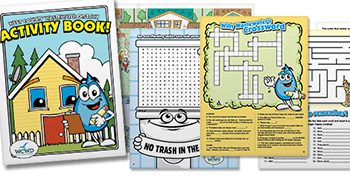When utilities think of communication and outreach, they typically think of their customer list. Those customers are the people that pay the bill monthly and are always adults. Therefore, it’s natural to create outreach targeted to adults and the current, paying customers you have.
I challenge you here to think differently. Have you considered focusing on kids? Some may immediately answer no, or maybe you’ve considered it but think that budgets aren’t available or are just unsure of how to go about it.
If presented correctly, reaching kids becomes a 2 in 1 outreach opportunity. How so? Well, if we, as professionals, can reach kids in an engaging and inspiring way, then those kids will go home and practice what they’ve learned. They will also happily tell their parents about it. Plus, parents may be more likely to listen to their kids and what they’ve learned than read the information on your website or in a bill.
Here’s a perfect example of how it works. Recycling programs are integrated into schools around the country. I can speak from experience that these programs not only educate kids on how to reduce, reuse and recycle, they also educate parents. How does this work? I lived it first hand through my children. Starting in Kindergarten they would learn what could be recycled and how to do it. Then, when they were at home, they would happily remind me when seeing me do it incorrectly at home. Kids are thrilled to share what they’ve learned at school; they also aren’t shy about correcting at the same time. It’s usually parents correcting and teaching kids, so when kids know something their parents don’t, the absolutely LOVE it.
There are many ways to go about reaching kids once you decide to do so. Providing age appropriate materials is critical to success. Also, focusing on content that kids can relate to is vital. When I say ‘relate’, I am referring to content that affects them. Kids, in preschool even, can recycle newspaper and cardboard. They can separate glass from plastics and paper. Kids can do these things and therefore the they get excited about being able to make an impact. Teaching 1st-2nd grade kids about hazardous waste disposal and oil running into storm drains is harder to get across because it is something they can’t do themselves or really even fix. So, picking content that allows kids to be impactful is important. Kids can help pick up dog waste and report if sprinklers are running on sidewalks rather than gardens and grass. Also, messages must be simple. All kids are different and like different types of activities. Some kids like to color, some kids like mazes, while other kids like seek and finds. Therefore, offer a variety so you get a wider reach of kids taking part in the activities.
As utility professionals, you may be inclined to want everyone, no matter the age to learn 10 things or everything about a topic, but we must be realistic. The goal should be more like 1 or 2 things for kids, at least to start.
To narrow it down a bit, keep in mind these 5 tips for kids activities and outreach:
1. What is the 1 thing you want kids to learn? Focus on that message
2. Provide a variety of activities to appeal to a variety of kids
3. Choose age appropriate materials
4. Keep it simple
5. Provide tips or actions to take
Hopefully you mind is opened to the opportunity of reaching kids and starting to create change in a younger demographic. Although some adults won’t change their ways, kids are learning so let’s teach them right from the beginning!

